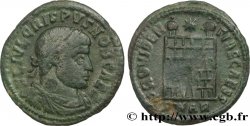brm_143530 - VITTORINO Antoninien
non disponibile.
Articolo venduto sul nostro negozio (2011)
Prezzo : 10.00 €
Articolo venduto sul nostro negozio (2011)
Prezzo : 10.00 €
Tipo : Antoninien
Data: c. début 271
Nome della officina / città: Trèves
Metallo : billone
Titolo in millesimi : 20 ‰
Diametro : 20 mm
Asse di coniazione : 6 h.
Peso : 2,81 g.
Grado di rarità : R1
Commenti sullo stato di conservazione:
Usure importante. Patine marron-gris
N° nelle opere di riferimento :
Diritto
Titolatura diritto : IMP C VICTORINVS P F AVG.
Descrittivo diritto : Buste radié, drapé et cuirassé de Victorin à droite, vu de trois quarts en avant (A).
Traduzione diritto : “Imperator Cæsar Victorinus Pius Felix Augustus”, (L’empereur césar Victorin pieux heureux auguste).
Rovescio
Titolatura rovescio : VICT-ORIA AVG.
Descrittivo rovescio : Victoria (la Victoire) courant à gauche, tenant une couronne de la main droite et une palme de la gauche.
Traduzione rovescio : "Victoria Augusti", (La Victoire de l'auguste).
Commento
Ce type, frappé à Trèves avec le buste drapé, pose un gros problème de classement avec le Schulzki. En effet, la planche accompagnant le numéro 22a (seul type avec Victoria pour Trèves) n’est pas celui décrit dans le texte... Cependant, c’est bien le plus courant des deux types, qui reste tout de même rare. L’autre type semble rarissime malgré le classement en C2 dans le même ouvrage.
This type, struck in Trier with the draped bust, poses a major classification problem with the Schulzki. Indeed, the plate accompanying number 22a (the only type with Victoria for Trier) is not the one described in the text... However, it is indeed the most common of the two types, which remains nonetheless rare. The other type seems extremely rare despite the classification in C2 in the same work
This type, struck in Trier with the draped bust, poses a major classification problem with the Schulzki. Indeed, the plate accompanying number 22a (the only type with Victoria for Trier) is not the one described in the text... However, it is indeed the most common of the two types, which remains nonetheless rare. The other type seems extremely rare despite the classification in C2 in the same work








 Segnalare un errore
Segnalare un errore Stampate la pagina
Stampate la pagina Condividi mia selezione
Condividi mia selezione Fai una domanda
Fai una domanda Consegnare / vendere
Consegnare / vendere
 Descrittivo
Descrittivo















